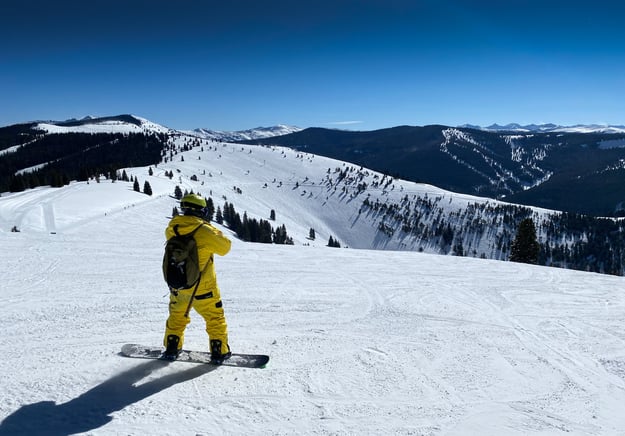With the ski season still in full swing, Vail is packed with eager skiers and snowboarders mapping out their paths to a special part of the mountain: Vail’s legendary back bowls. These expansive, ungroomed trails entice visitors to make some fresh turns or find that perfect line they have been searching for. Yet, the origin of the open landscape remains a mystery. What started the blaze that led to the amazing ski terrain we experience today?
The first theory about the mysterious creation of the back bowls involves a lucky lightning strike. Half of Colorado's wildfires are caused by lightning according to the National Weather Service, which means a thunderstorm is a likely cause. After lightning starts a blaze, a storm’s high winds can quickly spread flames far and wide, turning a large, forested area treeless within a few short days. This could explain the more than 300 acres of land the back bowls encompass.

Vail’s sparse back bowls are a unique feature of the mountain.
Another theory that has sparked interest involves the Ute people, whose native lands take up a large part of the western states—including almost all of Colorado. The story starts with the increased settler presence around the 1870s due to the rich mineral deposits of gold and silver found within the mountain landscapes. The greed of settlers and the Manifest Destiny mentality forced indigenous communities, through unjust and exploitative treaties and agreements, off of their native land. Following the Meeker incident on September 29, 1878, Colorado created the Ute Removal Act, which gave the go-ahead for the wrongful removal of the White River and Uncompahgre bands from their land to the Uintah Reservation. Some believe that, angry about their forced displacement, the Ute people burned the forest in the area we now know as the back bowls to discourage settlers.
Besides wondering how the fire started, we’re also left to ponder why the forest hasn't regrown since. With an increased presence of wildfires in the West, we are growing our understanding of how trees repopulate. Regrowth following a major wildfire is not a simple process. A 2018 study by Colorado State University noted that, prior to 2000, 19% of post-fire forests experienced no regeneration. It’s likely that fertilized cones have simply not found their way into the shrub- and grass-dominated area because of the increased space between trees. This study also showed that climate change has decreased the possibility of regrowth by almost half since 2000, meaning the unique back bowls may not be unique for much longer unless fires are managed carefully on the mountain.
The wide open terrain of the back bowls provides an experience that’s sometimes hard to find within the safety of resort boundaries. They were described by one of Vail’s founders, Pete Seibert, as “the most mind-blowing landscape of all: a series of bowls stretched to the horizon, a virtually treeless universe of boundless powder, open slopes, and open sky.” Was it a thunderstorm or was it members of the Ute tribe? Will that part of the landscape remain a treeless ski haven? These questions may always float over the landscape. Whether the inferno was a human-made or natural event, we are still able to understand the history of the land and the people that were forcibly removed from their land. Next time you venture into the back bowls, consider the perplexing and storied history of that rare place.
To learn more about the Ute tribe culture and connection to Eagle County and Colorado, visit the Southern Ute Website or the Ute Museum in Montrose.
Alice Dwyer is a Naturalist at Walking Mountains. She has a passion for skiing and appreciating the natural beauty surrounding the resorts.







